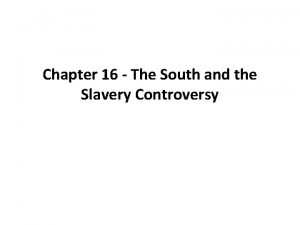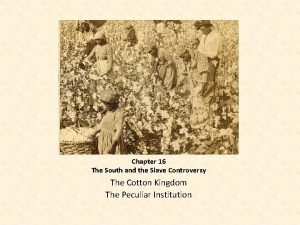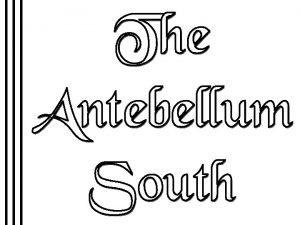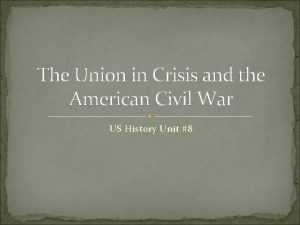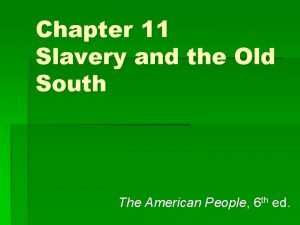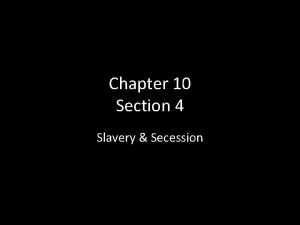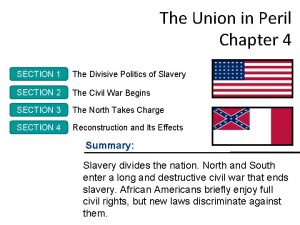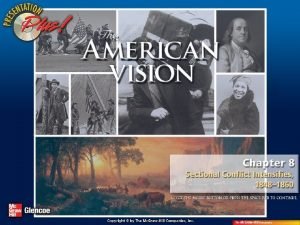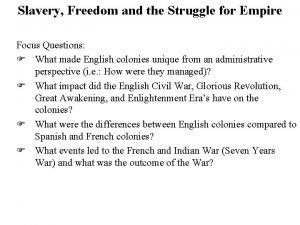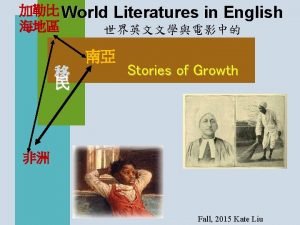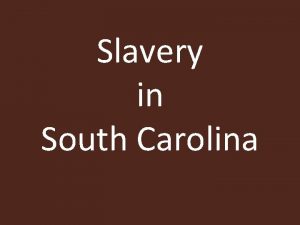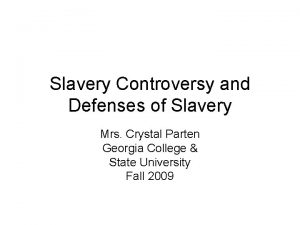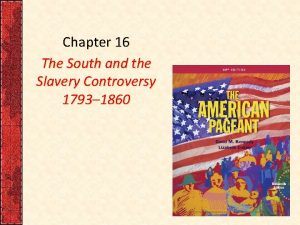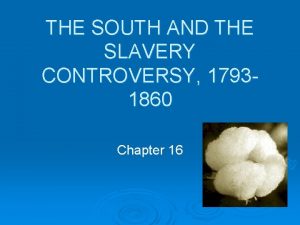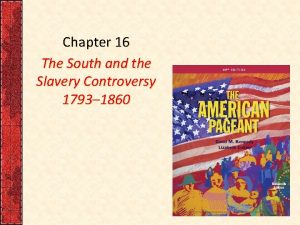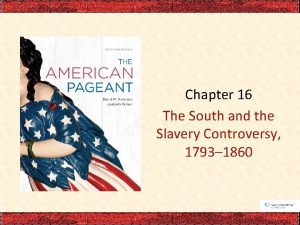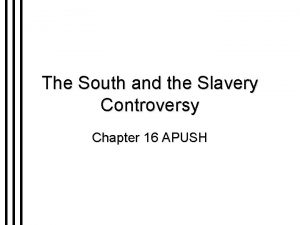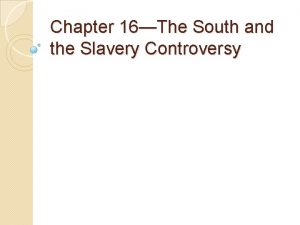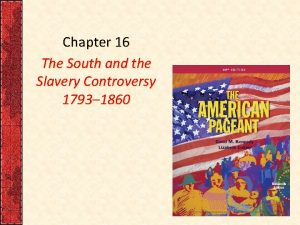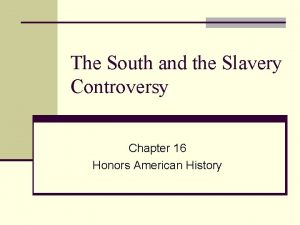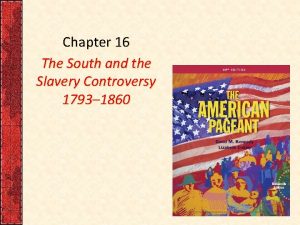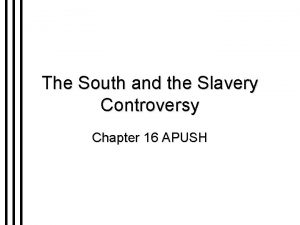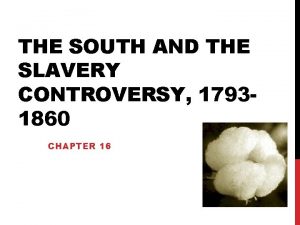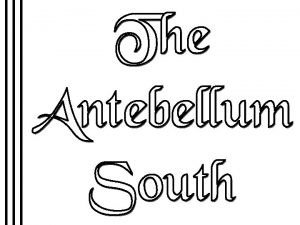Chapter 16 The South and the Slavery Controversy
















- Slides: 16

Chapter 16 - The South and the Slavery Controversy

Chapter 16: Essential Questions • Why did the South move from viewing slavery as a “necessary evil” to proclaiming it a “positive good”? • How effective were the abolitionists at achieving their goals? Did they hasten or delay the end of slavery? • Were basic freedoms jeopardized or forfeited with regards to Congressional action about the questions of slavery?

Copy the following: • As you take notes today, be sure to organize your notes in the following order 1. 2. 3. 4. 5. 6. 7. 8. “Cotton’s Is King!” The Planter “Aristocracy” Slaves of the Slave System The White Majority Free Blacks: Slaves Without Masters Plantation Slavery Life Under the Lash The Burdens of Bondage

“Cotton’s Is King!” • Before the 1793 invention of Eli Whitney’s cotton gin, slavery was a dying business, since the South was burdened with depressed prices, unmarketable goods, and over-cropped lands. – After the gin was invented, growing cotton became wildly profitable and easier, and more slaves were needed. • The North also transported the cotton to England the rest of Europe, so they were in part responsible for the slave trade as well. • The South produced more than half the world’s supply of cotton, and held an advantage over countries like England, an industrial giant, which needed cotton to make cloth, etc… • The South believed that since England was so dependent on them that, if civil war was to ever break out, England would support the South that it so heavily depended on.

The Planter “Aristocracy” • In 1850, only 1733 families owned more than 100 slaves each, and they were the wealthy aristocracy of the South, with big houses and huge plantations. They dominated society and politics • The Southern aristocrats widened the gap between the rich and the poor and hampered public-funded education by sending their children to private schools. – Also, a favorite author among them was Sir Walter Scott, author of Ivanhoe, who helped them idealize a feudal society with them as the kings and queens and the slaves as their subjects. • The plantation system shaped the lives of southern women. – Mistresses of the house commanded a sizable household of mostly female slaves who cooked, sewed, cared for the children, and washed things. – Mistresses could be kind or cruel, but all of them did at one point or another abuse their slaves to some degree; there was no “perfect mistress. ”

Slaves of the Slave System • The economic structure of the South became increasingly monopolistic because as land ran out, Due to excessive cultivation of cotton people began to move out West. Smaller farmers sold their land to the large estate owners. • Also, the temptation to over-speculate in land in slaves caused many planters to plunge deep into debt. – Slaves were valuable, but they were also a gamble, since they might run away or be killed by disease. • The dominance of King Cotton likewise led to a one-crop economy whose price level was at the mercy of world conditions, also discouraged a healthy diversification of agriculture. • Southerners resented the Northerners who got rich at their expense while they were dependent on the North for clothing, food, and manufactured goods. • The South repelled immigrants from Europe, especially those from Germany and Ireland who could not compete with slave labor, so they went to the North, making it richer with manpower.

The White Majority • Beneath the aristocracy were the whites that owned one or two, or a small family of slaves; they worked hard on the land with their slaves and the only difference between them and their northern neighbors was that there were slaves living with them. • Beneath these people were the slaveless whites (a full 3/4 of the white population) that raised corn and hogs, sneered at the rich cotton “snobocracy” and lived simply and poorly. They couldn’t afford slaves of their own. – Some of the poorest were known as “poor white trash, ” “hillbillies” and “clay-eaters” and were described as listless, shiftless, and misshapen. • Even the slaveless whites defended the slavery system because they all hoped to own a slave or two some day, and they could take perverse pleasure in knowing that, no matter how bad they were, they always “outranked” Blacks.

Free Blacks: Slaves Without Masters • • By 1860, free Blacks in the South numbered about 250, 000. In the upper South, these Blacks were descended from those freed by the idealism of the Revolutionary War (“all men were created equal”). In the deep South, they were usually mulattoes (Black mother, White father who was usually a master) freed when their masters died. Many owned property; a few owned slaves themselves. Free Blacks were prohibited from working in certain occupations and forbidden from testifying against whites in court; and as examples of what slaves could be, Whites resented them. In the North, free Blacks were also unpopular, as several states denied their entrance, most denied them the right to vote and most barred them from public schools. DISCRIMINATION WAS COMMON HERE TOO! Northern Blacks were especially hated by the Irish, with whom they competed for jobs. Anti-black feeling was stronger in the North, they were politically sympathetic towards blacks but wanted separation from them socially.

Plantation Slavery • Although slave importation was banned in 1808, smuggling of them continued due to their high demand despite death sentences to smugglers • However, the Main reason for slave increase (4 million by 1860) was mostly due to their natural reproduction. • Breeding slaves was not encouraged, but thousands of slaves were “sold down the river” to toil as field-gang workers, and women who gave birth to many children were prized. – Some were promised freedom after ten children born. • Slave auctions were brutal, with slaves being inspected like animals and families often mercilessly separated; Harriet Beecher Stowe seized the emotional power of this scene in her Uncle Tom’s Cabin.

Life Under the Lash • • Slave life varied from place to place, but for slaves everywhere, life meant hard work, no civil or political rights, and whipping if orders weren’t followed. As a substitute for the wage-incentive system, slaveowners used the whip as a motivator. However, lash beatings weren’t that common, since a master could lower the value of his slave if he whipped him too much. Forced separation of spouses, parents and children seem to have been more common in the upper South, among smaller plantations. Still, most slaves were raised in stable two-parent households and continuity of family identity across generations was evidenced in the widespread practice of naming children for grandparents or adopting the surname of a forebear’s master. In contrast to the White planters, Africans avoided marriage of first cousins. Africans also mixed the Christian religion with their own native religion, and often, they sang Christian hymns as signals and codes for news of possible freedom; many of them sang songs that emphasize bondage. (“Let my people go. ”) Deep South known as the “Black Belt” of the World.

The Burdens of Bondage • Slaves had no dignity, were illiterate, and had no chance of achieving the “American dream. ” • They also devised countless ways to make trouble without getting punished too badly. – They worked as slowly as they could without getting lashed. – They stole food and sabotaged expensive equipment. – Occasionally, they poisoned their masters’ food. • Rebellions, such as the 1800 insurrection by a slave named Gabriel in Richmond, Virginia, and the 1822 Charleston rebellion led by Denmark Vesey, and the 1831 revolt semiliterate preacher Nat Turner, were never successful. However, they did scare the jeepers out of whites, which led to tightened rules. • Whites became paranoid of Black revolts, and they had to degrade themselves, along with their victims, as noted by distinguished Black leader Booker T. Washington.

• DAY 2 NOTES!

Early Abolitionism • In 1817, the American Colonization Society was founded for the purpose of transporting Blacks back to Africa due to their widespread loathing, and in 1822, the Republic of Liberia was founded for Blacks to live. – Most Blacks had no wish to be transplanted into a strange civilization after having been partially Americanized. – By 1860, virtually all slaves were not Africans, but native-born African. Americans. • In the 1830 s, abolitionism really took off, with the Second Great Awakening and other things providing support. • Theodore Dwight Weld was among those who were inflamed against slavery. • Inspired by Charles Grandison Finney, Weld preached against slavery and even wrote a pamphlet, American Slavery As It Is.

Radical Abolitionism • • • On January 1 st, 1831, William Lloyd Garrison published the first edition of The Liberator triggering a 30 -year war of words and in a sense firing one of the first shots of the Civil War. Other dedicated abolitionists rallied around Garrison, such as Wendell Phillips, a Boston patrician known as “abolition’s golden trumpet” who refused to eat cane sugar or wore cotton cloth, since both were made by slaves. Orator of abolition David Walker, a Black abolitionist, wrote Appeal to the Colored Citizens of the World in 1829 and advocated a bloody end to white supremacy. Theordore Weld- American Slavery As It Is The greatest Black abolitionist was an escaped black, Frederick Douglass, who was a great speaker and fought for the Black cause despite being beaten and harassed. He wrote “The North Star” – His autobiography, Narrative of the Life of Frederick Douglass. • Elijian Lovejoy- Known as the martyr of abolition. Printing press destroyed 4 times

The South Lashes Back • In the South, abolitionist efforts increasingly came under attack and fire, around the 1830 s the voice of white southern abolitionism was silenced. • Southerners were in opposition to the North and the rest of the Western industrialized world. • Southern slave supporters pointed out how masters taught their slaves religion, made them civilized, treated them well, and gave them “happy” lives. • They also noted the lot of northern free Blacks, now were persecuted and harassed, as opposed to southern Black slaves, who were treated well, given meals, and cared for in old age. • In 1836, Southern House members passed a “gag resolution” requiring all antislavery appeals to be tabled without debate, arousing the ire of northerners like John Quincy Adams. • Southerners also resented the flood of propaganda in the form of pamphlets, drawings, etc…

The Abolitionist Impact in the North • For a long time, abolitionists like the extreme Garrisonians were unpopular, since many had been raised to believe the values of the slavery compromises in the Constitution. – Also, his secessionist talks contrasted against Webster’s cries for union. • • • The South owed the North $300 million by the late 1850 s, and northern factories depended on southern cotton to make goods. Many abolitionists’ speeches provoked violence and mob outbursts in the North, such as the 1834 trashing of Lewis Tappan’s New York House. In 1835, Garrison miraculously escaped a mob that dragged him around the streets of Boston. Reverend Elijah P. Lovejoy of Alton, Illinois, who impugned the chastity of Catholic women, had his printing press destroyed four times and was killed by a mob in 1837; he became an abolitionist martyr. Yet by the 1850 s, abolitionist outcries had been an impact on northern minds and were beginning to sway more and more toward their side.
 Chapter 16 the south and the slavery controversy
Chapter 16 the south and the slavery controversy Chapter 16 the south and the slavery controversy
Chapter 16 the south and the slavery controversy Key and peele slavery
Key and peele slavery How did bleeding kansas embody the slavery controversy
How did bleeding kansas embody the slavery controversy Chapter 11 cotton slavery and the old south
Chapter 11 cotton slavery and the old south Chapter 11 cotton slavery and the old south
Chapter 11 cotton slavery and the old south Chapter 10 section 4 slavery and secession
Chapter 10 section 4 slavery and secession Toward civil war lesson 3 secession and war
Toward civil war lesson 3 secession and war Chapter 4 section 1 the divisive politics of slavery
Chapter 4 section 1 the divisive politics of slavery Old south vs new south streetcar named desire
Old south vs new south streetcar named desire Is it a real issue with genuine controversy and uncertainty
Is it a real issue with genuine controversy and uncertainty Without controversy great is the mystery of godliness
Without controversy great is the mystery of godliness Nurture vs nature
Nurture vs nature Lesson 1 slavery and western expansion
Lesson 1 slavery and western expansion Slavery freedom and the struggle for empire
Slavery freedom and the struggle for empire What is coloniazation
What is coloniazation When urdu hindi controversy started
When urdu hindi controversy started
